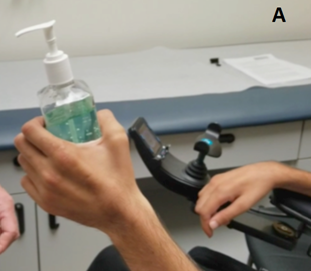Spinal Cord Injury
Utilizing Nerve Transfers to Improve Hand Function Following Cervical Spinal Cord Injury



Posted May 5, 2020
Wilson Z. Ray, M.D., Washington University School of Medicine in St. Louis

Dr. Wilson Z. Ray
Spinal cord injury (SCI) is a devastating and often debilitating condition. Over 50% of SCIs occur in the cervical spine, resulting in loss of arm and/or hand function, making complete recovery exceedingly rare.1 Upper extremity function is rated as one of the most desirable functions for persons with tetraplegia, ranking above bowel and bladder function, sexual function, standing, and pain control. Nerve transfer, a surgical method in which functionally redundant nerves are moved to a more critical area of motor function, has shown to be efficacious in the treatment of brachial plexus and peripheral nerve injuries.2 Compared to the traditional nerve grafting methods used to treat brachial plexus/peripheral nerve injuries, nerve transfers lead to improved reinnervation of motor endplates3 and limited-to-no functional deficit in the area of the donor nerve territory.4 To date, there are no clinical guidelines on the utilization of nerve transfers to treat patients with SCIs This leaves researchers and clinicians in search of new and innovative techniques to improve quality of life for cervical SCI patients.

Study participant displaying restored hand grip strength and function post nerve transfer
With support from a Fiscal Year 2014 (FY14) Spinal Cord Injury Research Program (SCIRP) Clinical Trial Award, Dr. Wilson Z. Ray and his team sought to establish and validate clinical guidelines on the use of nerve transfers to improve upper extremity function in patients with cervical SCI. To achieve this, cervical SCI patients with no hand function enrolled in Dr. Ray’s trial and underwent nerve transfer surgery, followed by post-operative therapy. After successful surgery and completion of hand therapy, all 19 patients experienced improvements in hand and upper limb function. Notably, two patients with C4 SCIs experienced an increase in muscle power from 0 to 4 on the Medical Research Council (MRC) scale on the side that received nerve transfer. The MRC scale rates muscle power when subjected to normal resistance. A 0 is no muscle activation and no range of motion and 5 is full activation and full range of motion. Despite hand function not being completely restored for these patients, both cervical SCI participants experienced improvements in hand sensation, including light touch. One patient is now able to operate a wheelchair equipped with joystick and a mobile phone, increasing independence and providing a boost in quality of life. One of the most exciting aspects of this award is that many participants are continuing to experience improvement, even as far as 3 years post-surgery.
Testimonial from study participant:
"As a C6 quadriplegic with no use of hands or fingers - this study was truly life-changing! After the nerve transfer surgery I am now able to pick up items I otherwise couldn't such as my toothbrush, medication, coins, glass of water, hold a pen to write, plug in my phone charger - anything that involves pinch of my fingers. I am eternally grateful for this study and Dr Ray's team for helping regain my independence back. Thank you!"
Restoration of hand and upper extremity function after cervical SCI would be a critical advancement in the current treatment paradigm for SCI-injured Service members and civilians. Dr. Ray’s thorough optimization of nerve transfer technique provides additional treatment options for patients with cervical SCI, which can lead to increased independence, psychological health, capacity to return to work, and overall better quality of life.
The results from this trial have led to a FY18 SCIRP Clinical Trial Award to Dr. Ray for an expanded, seven-site clinical trial implementing nerve transfers and targeted hand therapy into standard of care for individuals with limited hand function after SCI.
Publication:
Dibble CF, Khalifeh JM, VanVoorhis A, Rich JT, and Ray WZ. 2019. Novel nerve transfers for motor and sensory restoration in high cervical spinal cord injury. World Neurosurg 128:611-615. Doi: https://doi.org/10.1016/j.wneu.2019.04.264
References:
1Ackery A, Tator C, and Krassioukov A. 2004. A global perspective on spinal cord injury epidemiology. Journal of Neurotrauma 21:1355-1370.
https://www.ncbi.nlm.nih.gov/pubmed/15672627
2Dvali L and Mackinnon S. 2003. Nerve repair, grafting, and nerve transfers. Clin Plast Surg 30:203-221. PubMed PMID: 12737353.
http://www.ncbi.nlm.nih.gov/entrez/query.fcgi?cmd=Retrieve&db=PubMed&dopt=Citation&list_uids=12737353
3Kobayashi J, Mackinnon SE, Watanabe O, et al. 1997. The effect of duration of muscle denervation on functional recovery in the rat model. Muscle Nerve 20:858-866. PubMed PMID: 9179158.
http://www.ncbi.nlm.nih.gov/entrez/query.fcgi?cmd=Retrieve&db=PubMed&dopt=Citation&list_uids=9179158
4Mackinnon SE, Novak CB, Myckatyn TM, and Tung TH. 2005. Results of reinnervation of the biceps and brachialis muscles with a double fascicular transfer for elbow flexion. J Hand Surg Am 30:978-985. PubMed PMID: 16182054. https://www.ncbi.nlm.nih.gov/pubmed/?term=16182054
Link:
Last updated Thursday, December 5, 2024














